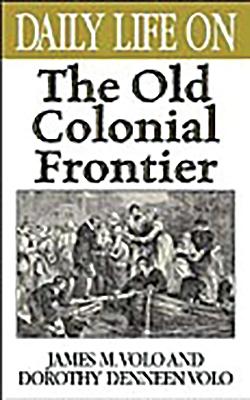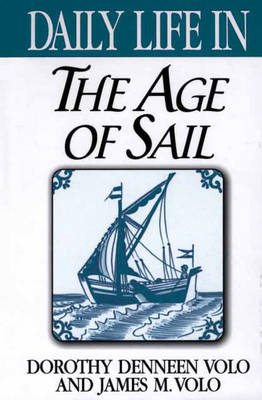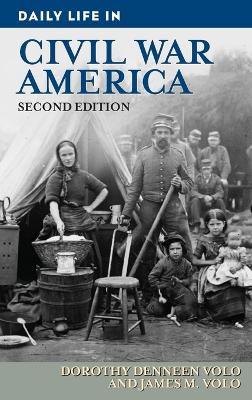Daily Life
5 total works
Daily Life on the Old Colonial Frontier
by James M Volo and Dorothy Denneen Volo
The frontier region was the interface between the American wilderness and European-style civilization. To the Europeans, the frontier teemed with undomesticated and unfamiliar beasts. Even its indigenous peoples seemed perplexing, uninhibited, and violent. The frontier wasn't just a place, but a process, too. It was a hazy line between colliding cultures, and a volatile region in which those cultures interacted.
This volume explores the frontier, explorers, traders, missionaries, colonists, and native peoples that came into contact. Everyday life is presented with all of its difficulties-the trading, trapping, and farming, not to mention the chronic threat of violence. Examining the period from the perspective of both Europeans and Native Americans, this book features over 40 illustrations, photographs, and maps, making it the perfect source for anyone interested in how people lived on the old colonial frontier.
Daily Life During the American Revolution
by Dorothy Denneen Volo and James M Volo
How did the patriot army dress themselves? What was the British soldier's food ration and what were women's roles during the revolution? What types of weapons did the combatants use and how large were the naval vessels of the day? This engaging and informative resource on the social and material history of the Revolutionary War period answers these and many other questions. Covering more than just political ideologies and the outcomes of battles, Daily Life During the Revolutionary War looks at the real stuff of history-people's lives and how they lived them.
Looking at the war and society from many angles, the book's 20 chapters cover such important topics as radicals, Tories, taxation, the French, the Hessians, prisoner-of-war conditions, fashion, leisure time activities, and war on the frontier, among others. Also included are more than 35 photographs and illustrations, and over a dozen charts. This behind-the-scenes look at history presents a fascinating picture of everyday life deeply affected by the spirit of '76.
Daily Life in Civil War America
by Volo Denneen, Dorothy Denneen Volo, and James M Volo
The United States Civil War touched the lives of every American North and South at that time. This informative book makes extensive use of journals, newspapers, and diaries to bring together the experience of the soldier, civilian, and slave in one volume. The experiences of Billy Yank and Johnny Reb are contrasted with activities on the homefront to bring this turbulent era alive for students, teachers and Civil War buffs.
This engaging history also provides interesting details such as: what the slaves' and the freed black men and women's lives were like; how the soldiers obtained their food; how recipes were changed to accommodate food shortages; the popular books and magazines of the time; and how clothing and fashion were affected by the war. The ideas and ideals which brought about the crisis are discussed and period writings are included to provide great insight into the mindset of the time. This volume is enhanced by period photographs, lithographs and original art work, much of which has never before appeared in print.
From the Thirteenth century through the Nineteenth, the waterways of the world provided the major means of transportation for exploration, trade, the military, and even criminals. Find out what life was like for those who chose to sail the high seas, as well as for those who didn't choose to be on board, like wives brought to sea by husbands and slaves en route to the auction block. What were their quarters like? What did they eat? How did they pass their long days at sea? These and other questions are answered in animated prose that brings the lives of ordinary people who oftentimes engaged in extraordinary activities, into sharp focus.
First-hand accounts from such sources as personal journals and magazine articles are provided to help bring the time period alive. Students will also learn what life was like in the seaport towns and what the sailors did when they visited these towns, as well as the physical parts of the ships and the different roles different members of the crew played. This engaging history helps to separate fact from fiction while exploring the reasons the sea and sea life have held such prominent roles in popular fiction, and will help students understand what life was truly like for these people.
Daily Life in Civil War America, 2nd Edition
by Dorothy Denneen Volo and James M Volo
Based on extensive research into newly discovered documents, this new edition of the popular volume offers an updated look at the daily lives of ordinary citizens caught up in the Civil War.
When first published, Daily Life in Civil War America shifted the spotlight from the conflict's military operations and famous leaders to its affect on day-to-day living. Now this popular, groundbreaking work returns in a thoroughly updated new edition, drawing on an expanded range of journals, journalism, diaries, and correspondence to capture the realities of wartime life for soldiers and citizens, slaves and free persons, women and children, on both sides of the conflict.
In addition to chapter-by-chapter updating, the edition features new chapters on two important topics: the affects of the war on families, focusing on the absence of men on the home front and the plight of nearly 26,000 children orphaned by the war; and the activities of the Copperheads, anti-Confederate border residents, and other Southern pacifist groups.
- Includes excerpts from a wide range of first-person original writings, including diaries, letters, journals, and newspaper articles
- Presents over 50 images, including photographs, posters, and contemporary illustrations, much of it from the author's own collection




